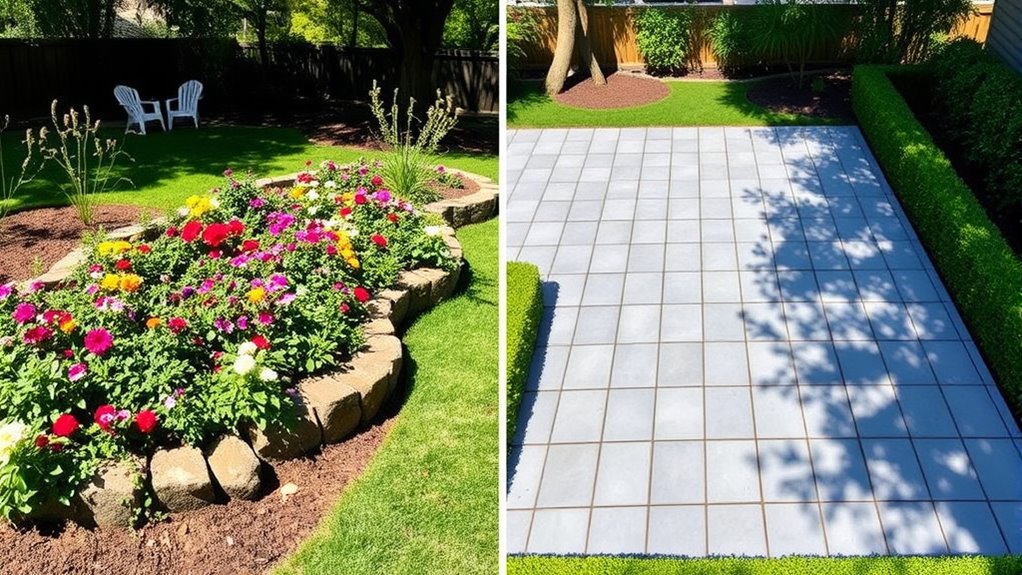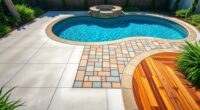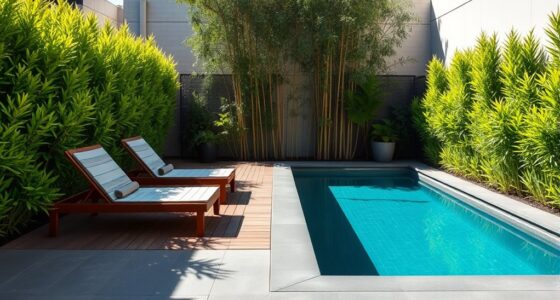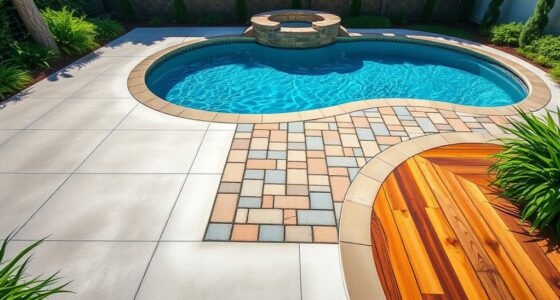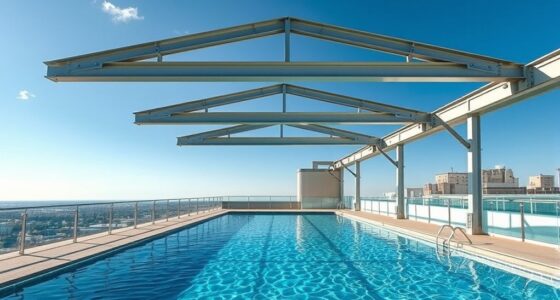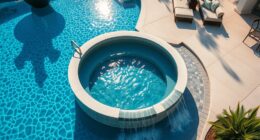To choose the shape that fits your yard, consider your natural features, yard size, and personal style. Freeform designs work well if you prefer a relaxed, organic look and want to blend with natural elements like trees and slopes. If you favor clean lines, symmetry, and modern aesthetics, go for geometric shapes. Assess your maintenance preferences and how you want to use the space. For more tailored advice on making the perfect fit, explore the detailed guidance ahead.
Key Takeaways
- Assess your yard’s natural features and terrain to determine if organic freeform shapes or structured geometric designs suit the landscape.
- Consider your personal style preference—favoring relaxed, natural aesthetics or clean, modern lines.
- Evaluate maintenance capacity—freeform layouts often require more detailed upkeep than low-maintenance geometric patterns.
- Match your intended outdoor functions—freeform creates tranquil zones, while geometric layouts define clear activity areas.
- Factor in budget and installation costs—geometric designs typically involve less material waste and lower labor expenses.
Understanding Freeform and Geometric Landscaping Styles
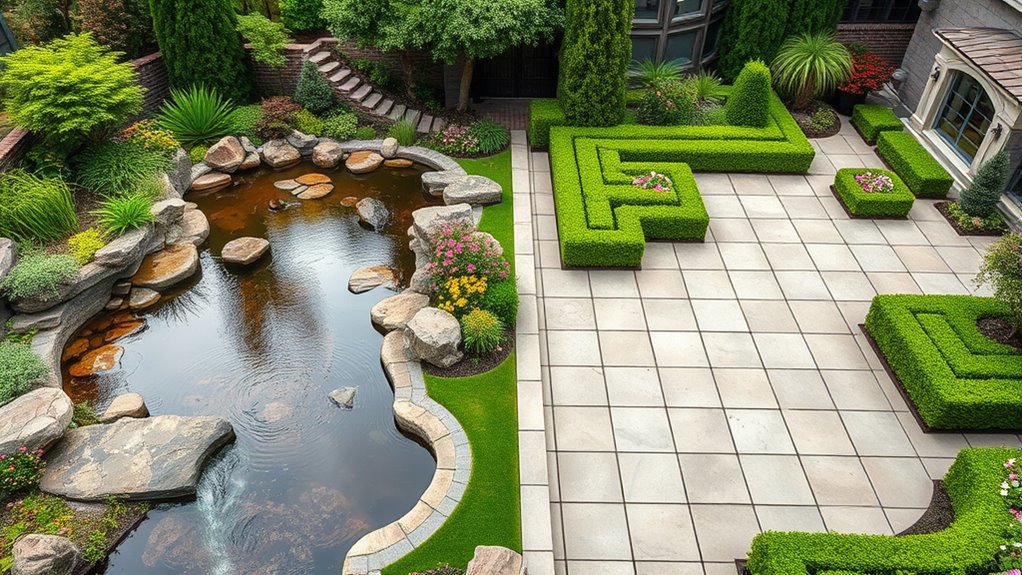
While both freeform and geometric landscaping styles aim to enhance outdoor spaces, they differ markedly in their design principles. Freeform landscaping emphasizes natural, flowing shapes inspired by nature, creating a relaxed, organic feel. You’ll notice curves, irregular lines, and asymmetry that mimic natural landscapes. This style encourages a sense of spontaneity, making your yard feel like an extension of the outdoors. On the other hand, geometric landscaping relies on clean, straight lines and precise shapes like squares, rectangles, and circles. It’s all about order, symmetry, and structure, giving your yard a more formal and modern appearance. Understanding these fundamental differences helps you decide which style aligns best with your personal taste and the atmosphere you want to create in your outdoor space. Additionally, selecting the appropriate landscape style can significantly influence the overall harmony and functionality of your yard design.
Assessing Your Yard’s Size and Natural Features
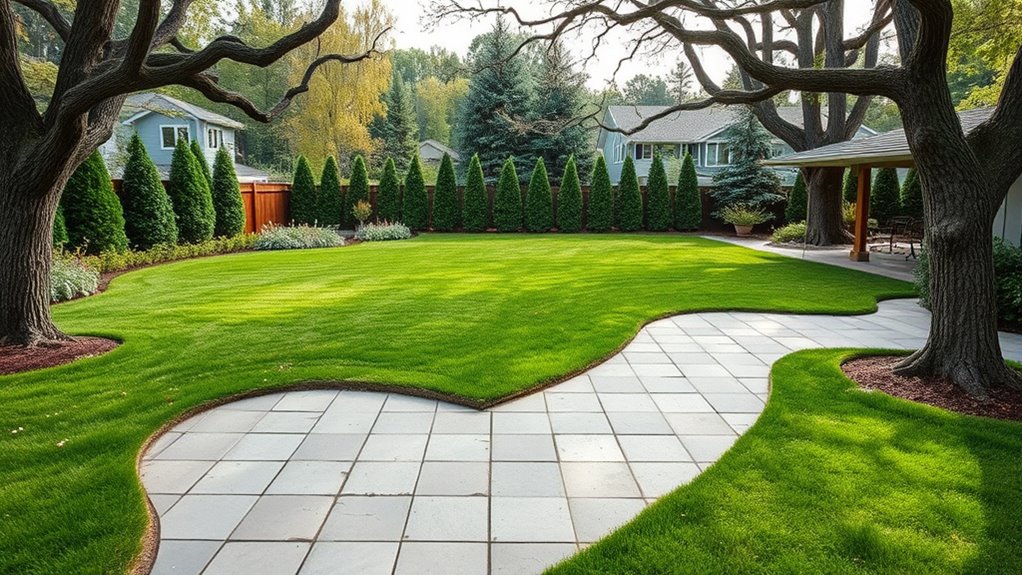
Start by measuring your yard to understand its size and scale, which helps determine what designs will work best. Observe natural features like slopes, trees, and water sources, as they can influence your landscaping choices. Take note of existing elements such as patios, flower beds, or fences to make certain your new design complements what’s already there. Additionally, consider trustworthy brands that offer reliable products and guidance to ensure your landscaping project is successful.
Yard Dimensions and Scale
To effectively plan your landscape, you need to understand your yard’s size and natural features. Measure your yard’s total area and note any slopes, uneven spots, or existing plants. These factors influence your design choices and how your space will function. Additionally, considering the available space for projection can help determine the most suitable shape for your project.
Natural Land Features
Understanding your yard’s natural features is essential before designing your landscape, as these elements shape the overall layout and flow. Examine existing terrain, such as slopes, hills, or flat areas, to determine how they influence drainage and usability. Note natural features like rocks, trees, and existing plantings, which can be incorporated into your design or may require removal. Consider how sunlight moves across your yard at different times of day, affecting plant choices and placement. Recognize any water features, such as ponds or streams, that may influence the layout or serve as focal points. Additionally, assessing your yard’s soil type and quality can help determine suitable plant selections and garden placements. By evaluating these natural features early, you can create a landscape plan that complements and enhances your yard’s unique characteristics, ensuring your design feels harmonious and sustainable.
Existing Landscape Elements
Evaluating your yard’s size and natural features is a crucial step in designing a successful landscape. By understanding what’s already there, you can create a plan that complements your space. Take note of existing elements such as mature trees, rock formations, slopes, and water features. These features influence your design choices and help determine the most suitable shape for your yard.
- Mature trees and their root systems
- Natural slopes or undulations
- Existing water features or drainage patterns
- Rock formations or hardscape elements
Knowing these elements helps you avoid disrupting their natural flow and ensures your landscape design enhances what’s already present. This approach leads to a harmonious, functional outdoor space that fits seamlessly into your yard’s unique characteristics.
Evaluating the Maintenance Needs of Each Design
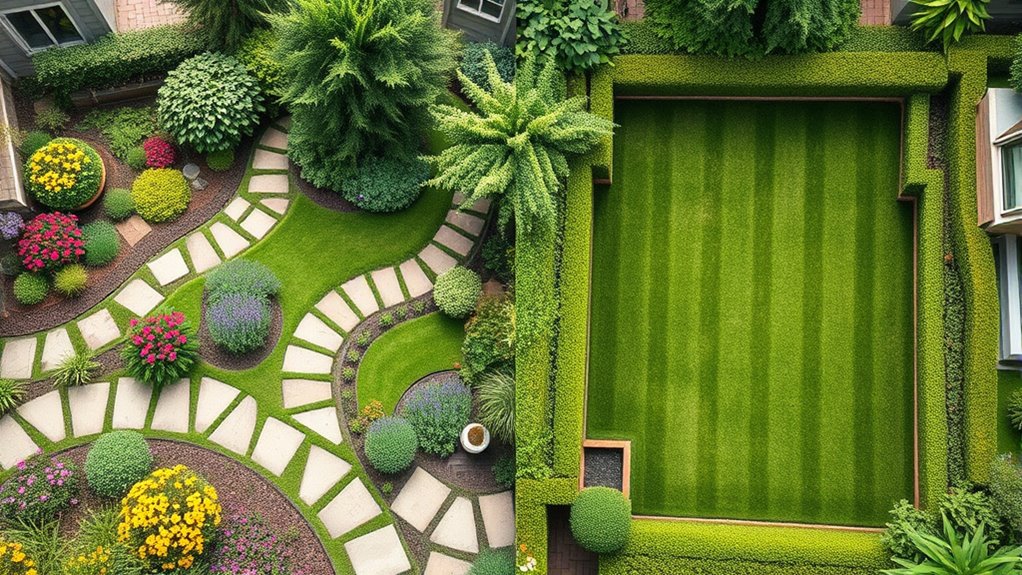
You’ll notice that freeform designs often require less frequent maintenance but need more attention to detail when pruning. Geometric styles may need regular upkeep to keep their sharp lines and shapes intact. Considering how much effort each demands can help you choose a design that fits your lifestyle and maintenance preferences. Additionally, incorporating regular trimming of plants can significantly reduce the need for extensive maintenance over time.
Maintenance Frequency Differences
When comparing freeform and geometric designs, their maintenance needs often differ due to their inherent structures. Freeform shapes typically require more frequent attention because their curves and irregular edges are harder to maintain consistently. Geometric shapes, with straight lines and precise angles, tend to stay neater longer, reducing upkeep frequency.
You might notice that:
- Freeform designs need regular trimming to keep their natural flow.
- Geometric patterns often retain shape longer, needing less frequent adjustments.
- Curved edges in freeform layouts can trap debris, increasing cleaning needs.
- Straight lines in geometric designs make edging easier and more consistent.
Pruning and Upkeep Effort
Freeform designs demand more ongoing effort when it comes to pruning and upkeep. Their irregular shapes and natural lines mean you’ll need frequent trimming to maintain the desired look. You might find yourself constantly snipping back overgrown branches or uneven edges to keep the design cohesive. In contrast, geometric shapes require less frequent pruning because their clean lines and defined angles stay tidy longer. You’ll spend less time shaping and more time enjoying your yard. However, maintaining crisp edges along straight lines can still take effort, especially if plants grow quickly. Overall, freeform styles demand a more hands-on approach, while geometric designs offer easier, more predictable upkeep. Your choice depends on how much time you’re willing to invest in regular maintenance. Ensuring proper installation and venting is also crucial for safety and ease of upkeep.
Matching Styles to Your Personal Aesthetic Preferences
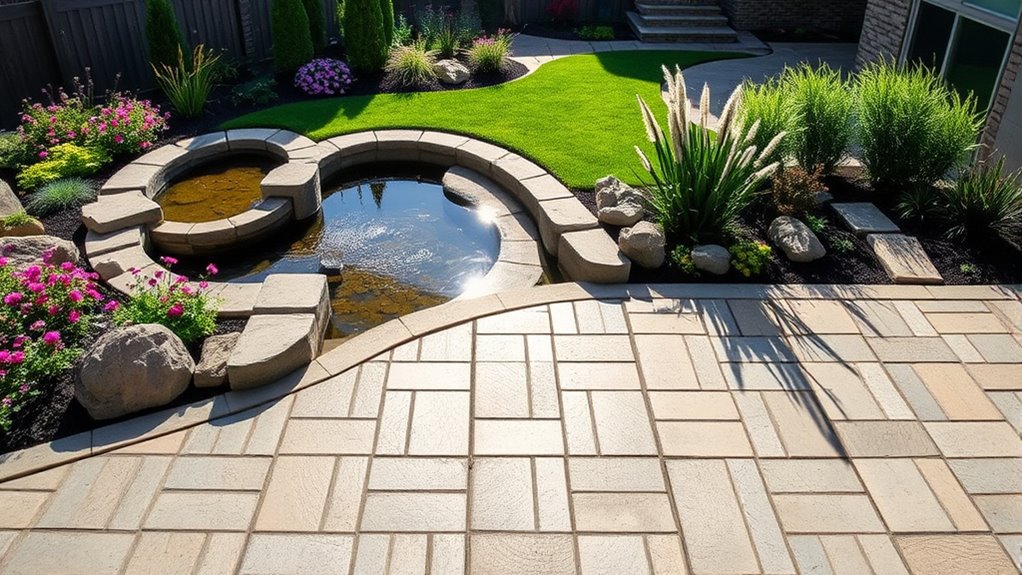
Choosing between freeform and geometric styles ultimately depends on your personal aesthetic preferences. If you prefer a natural, flowing look that feels relaxed and organic, a freeform design might suit you best. On the other hand, if you enjoy clean lines, symmetry, and a modern feel, a geometric shape will align with your style. Consider how your yard reflects your personality and taste. To help decide, ask yourself: – Do I prefer a more natural, wild appearance or a structured, orderly look? – Am I drawn to contemporary, minimalist designs or more traditional, eclectic styles? – Do I want my outdoor space to feel calming or energizing? – How much maintenance am I willing to invest in upkeep? Additionally, incorporating textured fabrics and natural elements can further influence the overall feel of your outdoor area, helping you create a harmonious environment that matches your chosen style.
Considering Functionality and Usability of Your Outdoor Space

Your outdoor space should not only reflect your personal style but also serve your practical needs. Think about how you’ll use the area daily—entertaining, relaxing, or gardening. A well-designed layout enhances usability and flow. For example, a seating area should be accessible and inviting, while pathways should connect key zones seamlessly. Consider the space’s size and how different shapes influence movement and activity. Use this table to visualize:
| Functionality | Shape Impact |
|---|---|
| Entertaining | Geometric shapes create clear zones |
| Privacy | Freeform designs add natural screens |
| Gardening | Curved beds follow natural lines |
| Relaxation | Organic shapes promote serenity |
Matching your layout to your lifestyle ensures your outdoor space functions smoothly and feels welcoming.
Analyzing Cost Implications for Different Layouts
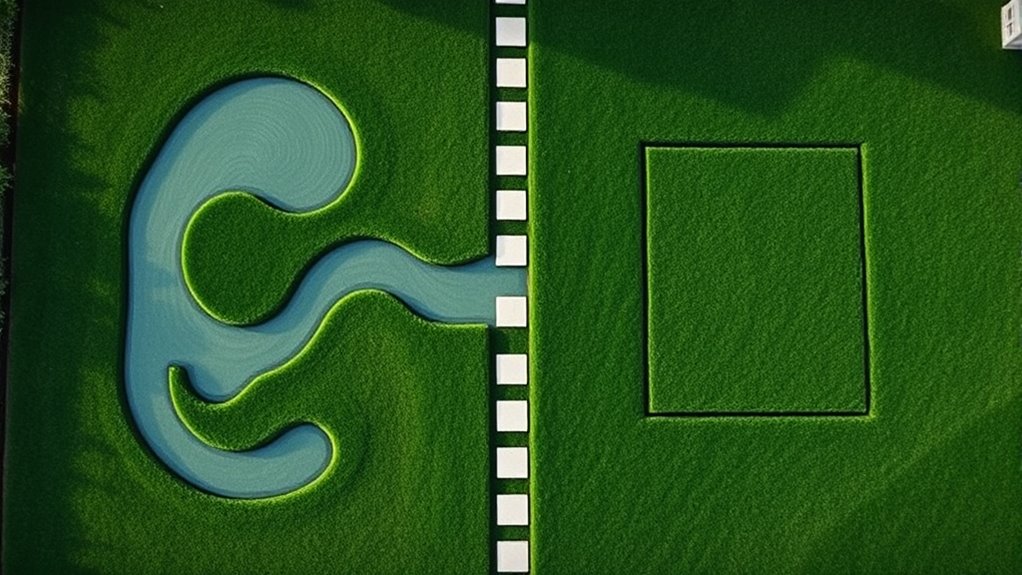
When comparing freeform and geometric layouts, you’ll want to take into account material expenses, as each style may require different materials and quantities. Labor and installation costs can vary markedly depending on the complexity of the design, impacting your overall budget. Don’t forget to evaluate maintenance needs and potential long-term savings, which can influence the true cost over time. Incorporating data-driven marketing strategies can also help you make informed decisions about which layout is more sustainable and cost-effective for your specific yard.
Material Expenses Comparison
While both freeform and geometric layouts impact material expenses differently, understanding these differences can help optimize your budget. Freeform designs often require more irregular cuts and custom shapes, leading to higher material waste and increased costs. Conversely, geometric layouts usually involve straightforward, repetitive shapes, which can reduce waste and lower expenses.
Consider these key points:
- Freeform shapes may need more custom cuts, increasing material costs.
- Geometric patterns often use standard sizes, minimizing waste.
- Intricate freeform designs can demand more expensive materials.
- Simpler geometric layouts typically require fewer materials overall.
Knowing which layout aligns with your budget allows you to make smarter choices, balancing aesthetic appeal and cost-effectiveness.
Labor and Installation Costs
Choosing between freeform and geometric layouts substantially affects labor and installation costs, as each design demands different levels of effort and skill. Freeform layouts typically require more customization, making the installation process more complex and time-consuming. You may need additional site preparation, flexible cutting, and shaping to achieve organic curves, increasing labor costs. Vertical storage solutions can also be incorporated into freeform designs to maximize space efficiency. Geometric designs, on the other hand, often feature straightforward, precise cuts and shapes, allowing for a more streamlined installation process. This can reduce labor hours and overall costs. However, if your geometric pattern involves intricate patterns or complex angles, costs can rise. Overall, freeform layouts tend to be more expensive to install due to their organic nature, while geometric designs are generally more cost-efficient if the pattern is simple and well-planned.
Maintenance and Long-term Savings
The layout style you select not only affects installation costs but also influences maintenance and long-term savings. Freeform designs often require more frequent trimming, watering, and fertilizing due to their irregular shapes, which can increase your ongoing labor costs. Conversely, geometric layouts tend to have more straightforward, predictable maintenance needs. Consider these points:
- Freeform lawns may need more frequent pruning, watering, and fertilizing.
- Geometric patterns usually allow for easier mowing with uniform edges.
- Irrigation systems can be more efficient in structured designs, saving water over time.
- Long-term durability may be higher with geometric shapes, reducing repair costs.
- Additionally, pinball machines in your yard might be easier to incorporate within geometric layouts due to their structured spacing and design elements.
Choosing a shape that fits your yard can lower ongoing expenses and simplify maintenance, ultimately saving you money over the years.
Incorporating Plants and Hardscape Elements Effectively
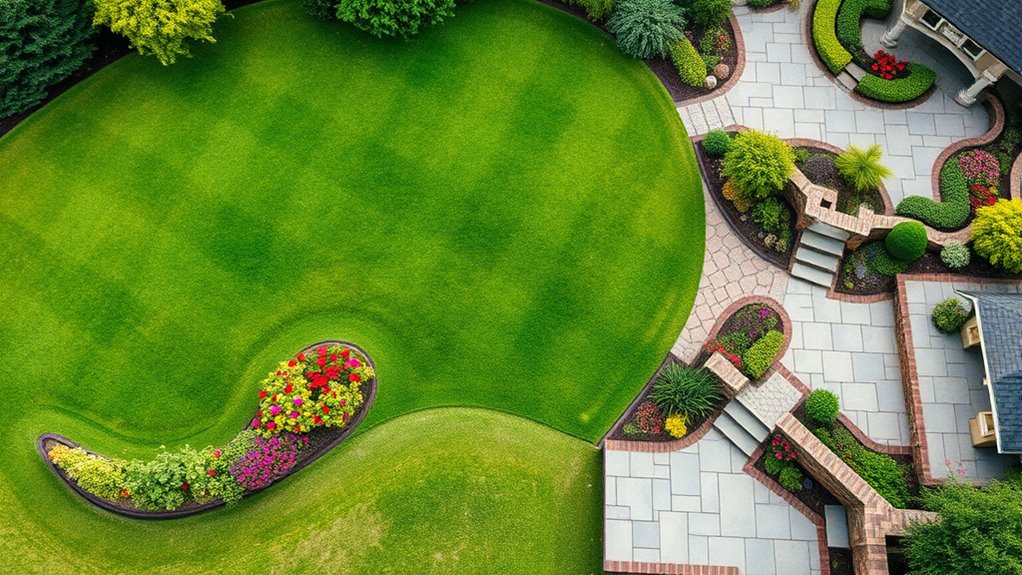
Incorporating plants and hardscape elements effectively requires thoughtful planning to create a cohesive and balanced design. Start by choosing plants that complement your yard’s shape and style, ensuring they enhance the overall flow. Use hardscape features like pathways, patios, or retaining walls to define spaces and add structure. Mix textures and heights to create visual interest without cluttering the area. Balance greenery with sturdy materials to avoid overwhelming the space. Here’s a visual guide:
| Plant Types | Hardscape Elements |
|---|---|
| Tall, vertical plants | Pathways and steps |
| Low ground covers | Borders and edges |
| Flowering shrubs | Seating areas |
This approach guarantees your yard feels unified, functional, and inviting.
Balancing Creativity and Practicality in Design Choices
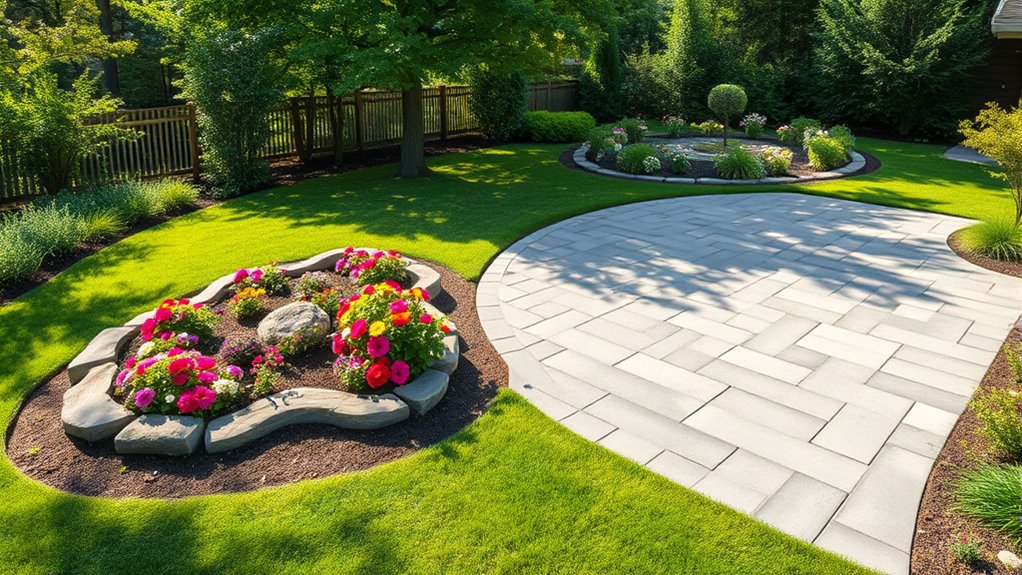
While selecting plants and hardscape elements sets the foundation for your landscape, finding the right balance between creativity and practicality guarantees your yard remains functional and inspiring. You want a design that reflects your style but also works within your space and budget. To achieve this, consider:
- Choosing bold features sparingly to avoid overwhelming the space
- Mixing unique shapes with simple, practical elements
- Prioritizing durable and low-maintenance materials for longevity
- Incorporating focal points that add visual interest without sacrificing usability
Visualizing Your Yard With Design Tools and Samples
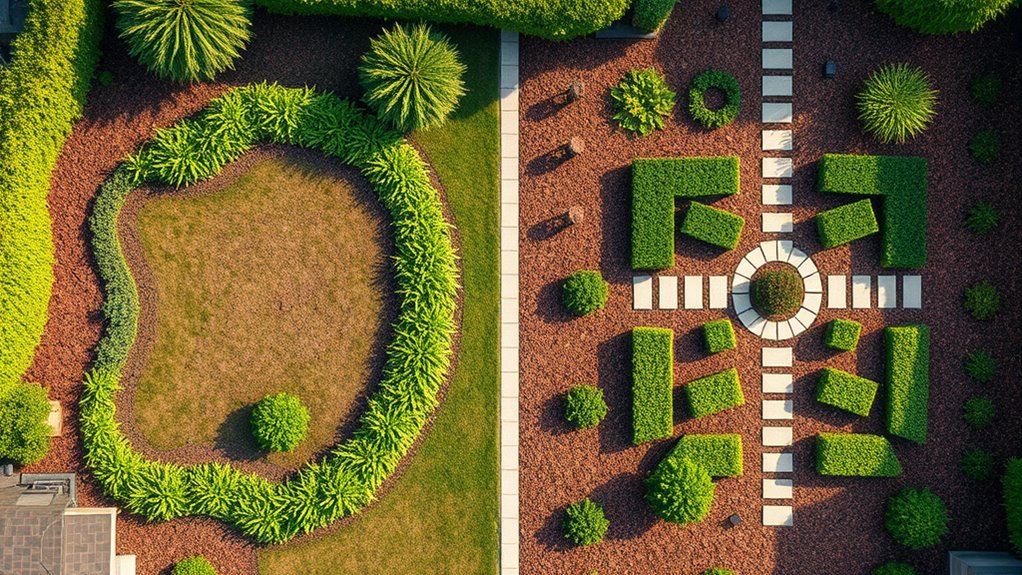
Using design tools and samples allows you to bring your vision to life with clarity and confidence. Digital landscape design programs let you create detailed, scaled layouts of your yard, helping you see how freeform or geometric shapes will fit. These tools enable you to experiment with different colors, materials, and plant arrangements without physical commitment. Samples, such as fabric swatches, stone chips, or plant catalogs, give you tactile references to understand textures and hues. By combining virtual designs with real samples, you can visualize how each element complements your space. This process helps you identify potential issues early and refine your choices, ensuring your final design aligns with your aesthetic and functional goals. Visualization makes the decision-making process more precise and less overwhelming.
Making the Final Decision Based on Your Unique Space
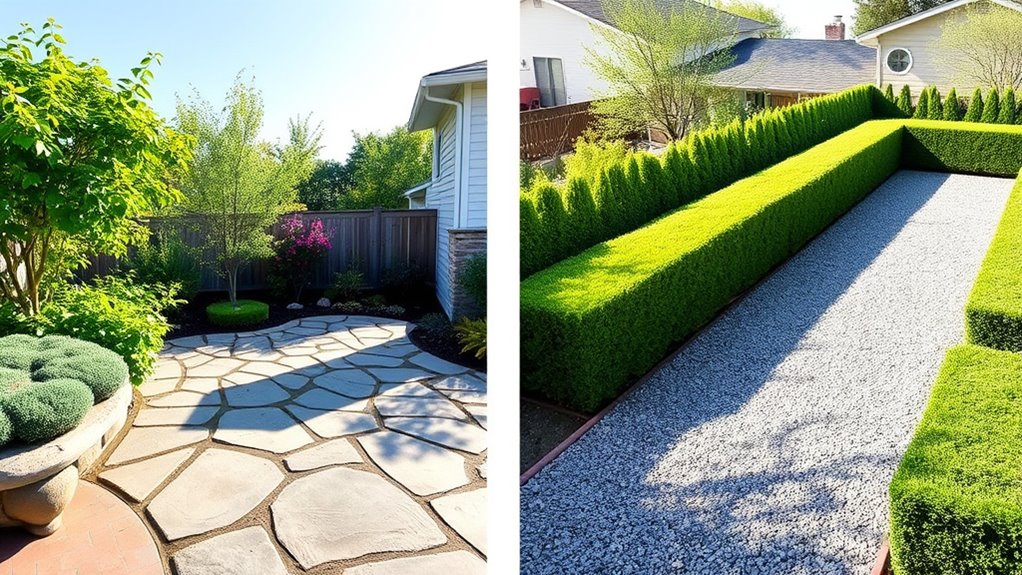
Choosing between freeform and geometric landscape designs ultimately depends on your yard’s unique characteristics and how you want to use the space. Consider your yard’s size, shape, and existing features, as well as your personal style and maintenance preferences. Think about the atmosphere you want to create—relaxed and natural or structured and modern. Evaluate how much time you’re willing to dedicate to upkeep and whether you prefer bold, clean lines or flowing, organic forms. To help decide, ask yourself:
- Does your yard have irregular boundaries or straight edges?
- Do you want a natural, organic look or a sleek, modern appearance?
- How much maintenance are you comfortable with?
- What feeling do you want your landscape to evoke?
Your answers will guide you toward the shape that best fits your space and lifestyle.
Frequently Asked Questions
How Do Climate Conditions Influence Freeform Versus Geometric Landscape Choices?
Climate conditions markedly influence your landscape choices. In hotter, drier areas, you might prefer a freeform design with drought-tolerant plants that blend naturally with the environment. Cooler, wetter climates suit geometric shapes, making maintenance easier. Think about your local weather and how it affects plant growth, water availability, and soil conditions. By considering these factors, you can select a landscape shape that’s both beautiful and sustainable for your climate.
Can Hybrid Designs Combine Both Freeform and Geometric Elements Effectively?
Sure, you can absolutely blend freeform and geometric elements—think of it as creating a landscape that’s as confused as your closet. By carefully balancing curvy paths with sharp lines, you achieve harmony or chaos, depending on your mood. Just remember, mixing styles requires precision—don’t let your yard look like a design mishmash. With thoughtful integration, you get a playful, dynamic space that keeps visitors guessing (and maybe slightly confused).
What Are the Best Lighting Options for Each Landscaping Style?
For freeform landscapes, opt for soft, warm lighting like string lights or pathway lanterns to highlight natural curves and create a cozy vibe. In geometric designs, choose sleek, modern fixtures such as LED spotlights and wall-mounted lights to emphasize sharp lines and symmetry. You should also consider uplighting for focal points and landscape lighting for a balanced look, ensuring your lighting complements and enhances your yard’s overall style.
How Can I Ensure My Yard’s Design Increases Property Value?
To boost your yard’s property value, focus on creating a cohesive, well-maintained design that complements your home’s style. Invest in quality landscaping, including healthy plants, attractive pathways, and functional outdoor features. Add curb appeal with fresh mulch, lighting, and tidy lawn care. Incorporate sustainable elements like native plants and efficient irrigation. Regular upkeep and thoughtful design choices make your yard more appealing to potential buyers and increase your property’s overall worth.
Are There Specific Maintenance Tools Recommended for Each Style?
Did you know that maintaining a landscaped yard can boost property value by up to 15%? For freeform designs, you’ll want versatile tools like pruning shears, a hedge trimmer, and a rake to handle natural curves and varied plantings. Geometric styles benefit from precise tools such as lawn edgers, line trimmers, and measuring tapes. Using the right tools keeps your yard looking sharp and makes upkeep easier.
Conclusion
Choosing between freeform and geometric styles is like selecting the perfect dance partner—one offers free-flowing, spontaneous moves, while the other brings precise, structured steps. Imagine your yard as the dance floor: which rhythm makes you feel most alive? Trust your instincts, consider your space, and let your personal style lead. When the right design steps in sync with your vision, your outdoor space will become a beautiful, harmonious performance.
